
Torso Wound Care Page Menu: 1 2 3 4 5 6 7 8 9 10 Next>>
Torso Wound Care During the Golden Age of Piracy, Page 3
Wounds of the Thorax - Penetrating Wounds: Medicines
A variety of medicines were employed when treating penetrating wounds of the chest. A variety of oral medicines were given to promote internal healing as well as to serve some other, more specific functions. Some medicines were applied topically on and around the wound site to encourage healing. When a tent was placed into such wounds, they were often medicated to assist healing. Sea surgeon John Moyle also mentions some other specific uses for medicines inserted into the open wound. Let's look at each of these medicinal applications.
Oral Medicines
German military surgeon Matthias Gottfried Purmann orders that "The Cure must begin, by administering 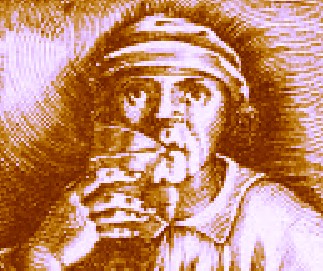
Artist: Jan van der Straet (1600)
proper Internal Medicines and Vulnerary [healing] Potions"1. Such oral medicines were often combined to help combat a variety of problems the physician or surgeon had encountered in penetrating chest wounds.
When treating a man in a lot of pain who was coughing up blood caused by a penetrating wound of the right side of the chest, Richard Wiseman prescribed "some syrup. de meconio [diacodin, an opiate, given for pain and to temper the flow of blood] & jujub. [syrup of jujube, used to stop coughing and thought to be good for problems of the breast] in a Draught of aq. Papaver. [poppy water, another opiate, for the pain] with a few drops spir. sulphuris [spirit or oil of sulfur, said to be good for curing problems of the internal organs]."2 Not surprisingly, the patient slept well after being given all those opiates.
The next morning, Wiseman gave him "decoct. pectoral. com. (the hotter Herbs left out)"3. Decoctum Pectorale Compound is a complicated mixture containing sarsaparilla, China roots, opium, raisins and liquorice, among other things. The reference to 'hot' herbs refers to the idea that each herb has humoral properties making it hot, cold, moist and/or dry. Licorice was considered very hot, so it would be left out based on Wiseman's advice.

Photo: Frank C. Müller - Jujube Fruit
'Hot' problems required cold remedies, so Wiseman seems to be saying that the chest wound was 'hot'. Wiseman sweetened this concoction "with syr. de ros. sicc. [syrup of dried roses, said to be drying and healing] & jujub. [syrup of jujube]."4 However, he hints that this treatment only met with limited success as the patient continued to cough up blood.
Sea surgeon John Moyle administered a haustus (oral medicine) in a case where a man had been pierced through the chest cavity below his collarbone. He notes that a
Cordial Haustus [was] given him to pacifie the Spirits and prevent a Coagulum of the extravasated [leaking] Blood in the Breast. It was this. Rx. Aq. Papver. Erratic. [Water of wild poppies, an opiate] {2 ounces} Syr. de Symphit. [syrup of comfrey, often given for internal wounds] {1 ounce} de Ros. Siccis [syrup of dried roses] {1/2 ounce} aq. Cordial. Frigid. Saxon. [cordial fridga saxony water, said to be cooling and relaxing] {6 drams} sperm. Ceti. [sperma ceti, good for clensing and healing, particularly in internal wounds] {1 dram} Misce. f. Haustus. [mix and make into a haustus or potion]"4
Notice that a number of the elements of Moyle's cure agree with those suggested by Richard Wiseman in the previous cure. Note also that he specifically gives a 'cooling' medicine, further suggesting this was a 'hot' problem from a humoral point-of-view.
Photo: Magnus Manaske - Papaver Somniferum, Opium poppy seed pods
Sea surgeon John Woodall suggested a different, more direct, regime of oral medicine for a penetrating chest wound. "Let thy cure be attempted with… syrupe of Violets [used by Woodall to cure 'inflammations of the breast'], and Hysope [hyssop, also recommended in disorders of the breast] and the like, unguentum potabele [drinkable ointment, used for healing wounds] drunke fasting {2 or 3 drams} for a dose"5
Opiates were commonly used to make patients sleep as several of the previous examples indicate. Military surgeon James Cooke explained in the case of a man shot near the backbone that he "seemed to be hopeless, could have no sleep, although I gave Laudan[um], to {3 grains} increasing by degrees to six, that only procured ordinary Sleep."6 Although this worked, he seems to regard the result as inadequate, indicating how potent laudanum was thought to be for this purpose. Hugh Ryder similarly treated a man wounded an inch below his right arm pit who had "slept not to well, [so] in his composing draught, I gave him sometimes fifteen or more drops of Liquid Laudanum"7.
1 Matthias Gottfried Purmann, Churgia Curiosa, 1706, p. 116; 2,3,4 Richard Wiseman, Of Wounds, Severall Chirurgicall Treatises, 1686, p. 368; 4 John Moyle, Memoirs: Of many Extraordinary Cures, 1708, p. 56-7; 5 John Woodall, the surgions mate, 1617, p. 139; 6 James Cooke, Mellificium Chirurgiæ: Or, The Marrow of Chiururgery, 1693, p. 131; 7 Hugh Ryder, New Practical Observations in Surgery Containing Divers Remarkable Cases and Cures, 1685, p. 40
Topical Medicines
Two sea surgeons recommended the use of topical medicines to treat penetrating chest wounds.
Sea surgeon John Moyle mentions a couple of different topical medicines. In one case study, Moyle recommends that the surgeon
_Francis_Hayman_mid_18th.jpg)
Photo: Francis Hayman (mid-18th c.)
anoint all the region of the breast, with oyl of hypericon [oil of St. John's wort, used to reduce pain and heal wounded sinews], and apply all over a good warm Emplaster of Paracelsi [Plaster of Paracelsus, reputed to be good in incised wounds to reduce pain and encourage the growth of new flesh]: This is the right way to digest and heal this kind of wound"1.
In another case study, Moyle applied the same medicines to the breast and shoulder of a man wounded by a puncture below his collarbone who was spitting up blood, over which a "Compress and Bandage was made."2 Once the man had stopped spitting up blood, Moyle removed the tent and
healed the Wound with a Pledget of Liniment. Arcei. [used to cleanse and heal wounds] and a Diapalma Implaster [also reputed to have wound healing properties] over it. And the Patient found himself easy and well every day, so I discharged him cured."3
Fellow sea surgeon John Woodall also advises topical medicines, although he is vague about which ones, apparently leaving that choice up to the reader. He notes that when "paine or the like accident shall be in any part of the Thorax, use Anodine [pain reducing] medicaments as well as Sanatine [probably sanative – medicines to promote healing and well being], lest paine hinder [the patient's] rest, and overthrow all."4
Military surgeon James Cooke recommends a medicine for wounds of the lungs which corresponds with those mentioned by Moyle. He tells the surgeon to "drop in Liniment. Arcei cum Ol. Hyperic. vel [or] Bals. Artific. [this is another term for oil of St. John's wort] On them apply Empl. Diapal[ma]."5
1 John Moyle, Abstractum Chirurgæ Marinæ, 1686, p. 56; 2 John Moyle, Memoirs: Of many Extraordinary Cures, 1708, p. 57; 3 John Moyle, Memoirs, p. 58; 4 John Woodall, the surgions mate, 1617, p. 139; 5 James Cooke, Mellificium Chirurgiæ: Or, The Marrow of Chiururgery, 1693, p. 130
Inside Wound Medicines
Some medicines were actually placed into penetrating chest wounds
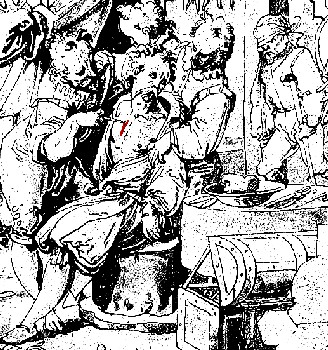
Artist: Chistoph Maurer
Operating on a Soldier's Chest Wound, Wellcome (1594)
to facilitate healing. Many of these were applied to the tents (folded pieces of material put into a wound to keep it open). Hugh Ryder mentions using a balm called Balsamum Lucatelli1 which contained yellow wax, canary wine, olive oil, and Venice turpentine washed in rose water. Apothecary John Quincy says this balsam is considered "an internal Vulnerary [healing medicine], and is prescribed in such Coughs as give suspicion of Tubercles [lesions] and Ulcerations in the Lungs; and also in all Internal Decays from like Causes"2.
Richard Wiseman discusses a number of medicines he used on tents. In one case, Wiseman suggests that the tent should be
In another case, he advises the use of different medicines:dipt in a mixture of Powder composed of bol. Armen. [Armentian earth - used to heal wounds and contract flesh] Sang. dracon. [dragon's blood resin - closes wounds and stops bleeding] thus, [frankincense - to generate flesh in wounds, though particularly good in penetrating wounds of the chest ] mastich. [used to heal wounds of the lungs] &c. cum albumine ovi [egg yolk, an agglutinative], and applied over it a Pledgit [a piece of lint] spred with the same, also empl. é bolo [a plaster composed of oil, litharge or elemental lead, and sealed earth], with convenient Bandage.5
I drest up the Wound with a short Tent dipt in a little terebinth. [turpentine - good in wounds of the lungs] cum farin. volatili [with mill dust - used to stop bleeding], and a few of our agglutinative [adhesive - referring here to bringing the skin back together so it could heal] Powders mixed with the Yolk of an egg, and applied empl. diachalcit[oes] [a plaster which encourages healing, combats pain and poisons] over it3.
Wiseman goes on to say in this case that he continued this dressing daily

Bdellium Resin
until the wound was cleansed and internally healed. At this point he modified the medicines:
I kept the Orifice open by a short hollow tent made of a Sparadrope [sparadrap - an adhesive plaster], which was composed of resin. pin. [pine resin - probably used for its adhesive properties] gum. ammoniac. [a medicine to cleanse wounds and remove clots, reputed good for the chest] bdellium [used to digest wounds, reputed good in disorders of the breast], galban[um]. [good for problems of the upper chest] terebinth. [turpentine] & cera [wax], with pulv. ireos [powdered iris root - a 'Pectoral' which is reputed good for wounds of the breast], dipping in a little mel. ros [honey of roses - used to cleanse and stop bleeding]. This way of dressing I continued until the coughing of bloud diminished, from 12 Napkins in a day and night to 10, 8, 7, 4, 2, 1; yea to 1 in a week4.
Sea surgeon Moyle suggests another compound medicine be applied to a tent for healing a wound of the chest under the collarbone:
Moyle also mentions a couple of medicines which he applies to tents to stop a wound from bleeding. In one case, he recommended the surgeon "dip a small tent in Aqua Stiptica Vitroili [a styptic water], and the glare [glair – white] of an Egg beaten together, this will stop the bleeding powerfully"6. He advises covering this tent with a bandage "squeezed out of the same Liquor, and applyed: This wound must be kept open by all means, otherwise it will quickly heal outwardly, and there will be an Empyema [trapped collection of pus] inwardly"7.Rx. Tereb. Cypr. {2 ounces} [Cypress turpentine - used to draw the body's tissue together] Vitell. Ov. [one egg yolk, having aggutinative qualities] Farin. Hord. [barley meal] q.s. [as much as needed] Pulv. Croc. [powdered saffron - considered good for problems of the lungs] {1/2 ounce} Misce. [mix] The Turunda [tent] was armed with this and applied with its Filum [string tied to it for removal]8
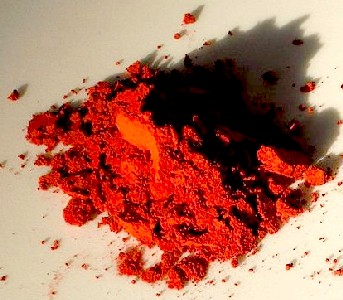
Photo: Andy Dingley
Sanguis Draconis or Dragon's Blood Resin Powdered
In another case studies, Moyle stopped the bleeding of a chest wound created by a pike using "Rx. Pulv Thur. [powdered frankincense, which is 'binding'] Sang. Dracon. [dragon's blood resin, 'agglutinating'] Mastic. {of each a dram} Alb. Ov. [egg yolk, agglutinating] q.s. [as much as is needed] Acet. Vini. [vinegar of wine, reputed to stop fluids from flowing] Parum. Misce. [mixed in equal quantities]"9 He dipped a tent in this and placed it in the wound.
In addition to tent-based medicines, John Moyle recommended swabbing the wound to stop bleeding. He tells his reader "you must arm your long Probe with a fine Flamula [piece of soft cloth], and dipping it in Aq. Stiptica [literally 'styptic water'], (or else acetum Vini [vinegar of wine]) and after sprinkling it with Pulv restring. major [a powder to restrict bleeding]; you must pass it through the Wound, and let it [the medicine] remain in"10.
Moyle also suggests using a syringe to inject medicines directly into a chest wound. (Note that syringes at this time were usually pewter and had much larger 'needles' which did not actually penetrate the skin.) He recommended that in later dressings, the surgeon should
wash it [the wound] with Tincture of Myrrhæ [tincture of myrrh, used here to cleanse and heal the wound], and quint. Aristoloch. Fabri [quintessence of aristolochia rotunda, also being used here to cleanse and heal wounds], with a Syringe, but let the Patient be placed so, as the wound may be lowest, that what is syringed into it; as also the matter may come forth of it, and let him lye so in his Cabbin or Cradle [a cradle was a temporary structure that was set up to serve as a bed for the wounded].11
Note that a significant part of Moyle's treatment plan involves making sure that the medicine can get back out of the wound.
Military surgeon James Cooke similarly advises the surgeon when treating wounds of the lungs, "[i]f you have a mind to inject, you may cast in some of the Vulnerary [healing] decoctions".12
1 Hugh Ryder, New practical observations in surgery, 1685, p. 40; 2 John Quincy, Pharmacopoeia Officinalis & Extemporanea, 1722, p. 488; 3,4 Richard Wiseman, Of Wounds, Severall Chirurgicall Treatises, 1686, p. 369; 5 Wiseman, p. 367; 6,7John Moyle, Abstractum Chirurgæ Marinæ, 1686, p. 55; 8 John Moyle, Memoirs: Of many Extraordinary Cures, 1708, p. 57; 9 Moyle, Memoirs, p. 56; 10 John Moyle, Chirugius Marinus: Or, The Sea Chirurgeon, 1693, p. 80; 11 Moyle, Abstractum, p. 55; 12 James Cooke, Mellificium Chirurgiæ: Or, The Marrow of Chiururgery, 1693, p. 131
Wounds of the Thorax - Penetrating Wounds: Humoral Treatments
Humors were an important part of medicine during this period. Since wounds were believed to corrupt humors of the body, several treatments were advised to prevent humors from reaching the wound site or to extract those that were collected there.
The most common humoral method employed in chest wounds was bleeding the patient.
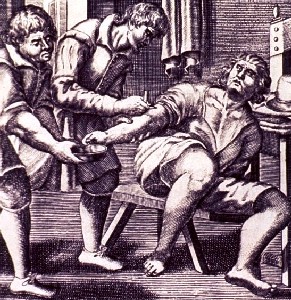
Bloodletting In the Arm, From Nuova et Utlilssima
Prattica di Tutto Quello by Cintio d'Amato (1671)
This is recommended by nearly every surgeon under study who comments on chest wounds.1 Military surgeon Richard Wiseman gives us the most specific details about bleeding in his case studies. He uses the technique repeatedly in his cases. For example he mentioned that he performed "frequent Phlebotomy"2 in a penetrating wound of the ribs, "let [a patient] bloud ...often" in another case, "repeated Venæsection"3 in yet another case and noted "Bleeding was repeated"4 in a fourth case.
Wiseman sometimes gives other interesting details about bloodletting in these cases, including the location of bleeding the patient and the amount of blood he took. For a man wounded 'in the right breast', he explains that he "took away ten ounces of bloud presently"5. While consulting with other health professionals on a wound to the breast, he explains that they "agreed he should be let bloud presently; which was done accordingly in the left Arm. The bloud flowing with a quick stream, we took away about 6 or 7 ounces, a meer Serum: but the Patient was relieved by it."6
Sea surgeon John Moyle discusses the reason for bloodletting in puncture wounds of the chest. In a case involving a wound under the left collarbone, he explains that the man had "not bled much at the Wound, [so] I made Phlebotomy in the Arm"7. Fellow sea surgeon Hugh Ryder likewise observes of a man pierced with a rapier in the armpit that "he bled not much at the Wound; wherefore I took away about fourteen ounces of Blood"8. Moyle gave a second reason for bleeding a patient. In a case where the patient was spitting up blood while his wound simultaneously released a lot of blood, the man "had Venæ Section [bloodletting] again, though but small quantity, this much relieved him"9. This suggests that bleeding the patient would divert blood away from the wound and prevented it both from being spit up as well as gathering at the wound site.
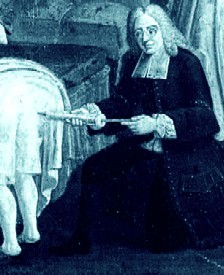
Administering an Enema (1700)
Another humoral treatment found in several of the golden age of piracy accounts is the administration of enemas. Moyle details in the case of the man wounded under the left collarbone that "he had Enemas often repeated, for in these and the inward Means lay the greatest Stress of the Cure."10 Although he doesn't mention enemas as frequently as bleeding, Richard Wiseman says in one wound penetration case that clysters (a period term for enemas) are "proper in such cases"11. Hugh Ryder also believed in this course, reporting that a patient he had under care received "Glysters (yet another word for enema) every day, or at least every other day"12. Never one to miss such an opportunity, John Woodall advises using 'glisters' in penetrating chest wounds.13
The last humor-oriented suggestion found in some of the period texts involves the patient's diet. This has a more indirect connection to humor theory than the other two methods, but food was considered vitally important to the creation of effective humors needed to nurture an ailing body. Woodall vaguely recommends that the "cure be attempted with good diet as is said"14. Hugh Ryder and military surgeon James Cooke are a bit more specific, recommending a 'thin' diet.15 Cooke also adds that "the party [should be kept] very quiet, speak little, and beware of anger"16, all things thought to produce imperfect humors.
1 For examples, see John Woodall, the surgions mate, 1617, p. 139, John Moyle, Abstractum Chirurgæ Marinæ, 1686, p. 56, Richard Wiseman, Of Wounds, Severall Chirurgicall Treatises, 1686, p. 367-9 & James Cooke, Mellificium Chirurgiæ: Or, The Marrow of Chiururgery, 1693, p. 131; 2,3 Wiseman, p. 368; 4 Wiseman, p. 369; 5 Wiseman, p. 368; 6 Wiseman, p. 367-8; 7 John Moyle, Memoirs: Of many Extraordinary Cures, 1708, p. 56; 8 Hugh Ryder, New Practical Observations in Surgery Containing Divers Remarkable Cases and Cures, 1685, p. 39; 9,10 Moyle, Memoirs, p. 57; 11 Wiseman, p. 369; 12 Ryder, p. 40; 13,14 Woodall, p. 139; 15 Ryder, p. 40 & Cooke, p. 132; 16 Cooke, p. 132

